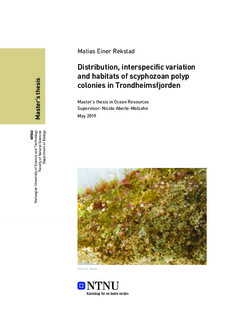| dc.contributor.advisor | Aberle-Malzahn, Nicole | |
| dc.contributor.advisor | Majaneva, Sanna | |
| dc.contributor.author | Rekstad, Matias Einer | |
| dc.date.accessioned | 2019-09-21T14:00:15Z | |
| dc.date.available | 2019-09-21T14:00:15Z | |
| dc.date.issued | 2019 | |
| dc.identifier.uri | http://hdl.handle.net/11250/2618089 | |
| dc.description.abstract | Manetoppblomstringer er fremdeles et emne med høy økonomisk og økologisk betydning. Det er også en pågående debatt om hvorvidt frekvensen og intensiteten av maneoppblomstringer øker eller ikke.
Kombinert med tvetydige data om manetoppblomstringer, og potensialet av å utnytte maneter som en nyttig ressurs, har ført til at det EU finansierte prosjektet GoJelly og lignende innsatser nå forsøker
å øke vår kunnskap om manetøkologi, populasjonsdynamikk og faktorer som promoterer dem.
Særlig med tanke på økologien av stormanerpolypper som til nå er lite undersøkt i forhold til andre vanlige bentiske organismer. Derfor var målet med denne masteroppgaven å undersøke økologien til stormanetpolypper i Trondheimsfjorden og området utenfor fjorden.
Mer spesifikt, å studere deres distribusjon, interspesifikk variasjon, habitater, mikrohabitater, samt biotiske interaksjoner mellom polypper og andre epibionter. For å fullføre disse målene ble en feltundersøkelse iverksatt og «settling plates» ble plassert på flere stasjoner langs en transekt av Trondheimsfjorden og området utenfor fjorden. Aurelia aurita polyppkolonier ble bekrefter langs hele transekten, mens polypper av Cyanea capillata og Cyanea lamarckii ble ikke funnet. Små, grunne og lite eksponerte bukter i littoralsonen var levedyktige habitater for A. aurita polypper. Strukturen og overflaten til Ascidia mentula (sjøpung), Pomatoceros triqueter (børstemark), og døde Balanus balanoides (rur) promoterte levedyktige mikrohabitater. Mytilus edilus (blåskjell) framsto som en potensiell konkurrent for mat og plass, mot andre epibionter, inkludert polypper. | |
| dc.description.abstract | Jellyfish blooms continue to be a topic of economic and ecological concern.
There is still an ongoing debate if the frequency and intensity of jellyfish blooms is increasing or not.
Combined with the discrepancy of data regarding jellyfish blooms, and the potential to exploit jellyfish as a useful resource, the EU-funded project GoJelly and similar efforts are now trying to increase our knowledge on jellyfish ecology, population dynamics and the factors promoting their occurrence. Particularly on the importance of scyphozoan polyp ecology, which is presently a scarcely investigates subject compared to other common benthic organisms. Thus, the aim of this master thesis was to investigate the ecology of scyphozoan polyp colonies within and outside of Trondheimsfjorden. More specifically, to study their distribution, interspecific variation, habitats, microhabitats and the biotic interactions between polyps and other settling epibionts. In order to achieve the listed goals, a field survey was performed and settling plates were deployed at several stations along a transect within and outside of Trondheimsfjorden. The occurrence of Aurelia aurita polyp colonies were confirmed throughout the whole transect, while polyps of Cyanea capillata and Cyanea lamarckii were not found. Shallow, embayed and sheltered littoral zones were viable A. aurita polyp habitats. The structural and surface characteristics of Ascidia mentula (solitary ascidian), Pomatoceros triqueter (polychaete) and dead Balanus balanoides (barnacle) shells promoted viable polyp microhabitats. The blue mussel Mytilus edilus proved to be a potential competitor of space and food towards other settling epibionts,
including A. aurita polyps. | |
| dc.language | eng | |
| dc.publisher | NTNU | |
| dc.title | Distribution, interspecific variation and habitats of scyphozoan polyp colonies in Trondheimsfjorden | |
| dc.type | Master thesis | |
